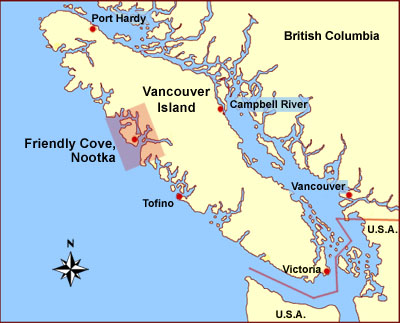SAIL TRAINING
CYA INSTRUCTION
CHARTERS
ADVENTURE TRAVEL

TEL: (604) 689-1647
FAX: (604) 669-2888
TOLL FREE (800) 661-9133
WWW.SEABC.COM
EMAIL:bewley@seabc.com
SAIL TRAINING |
|
|
 Friendly Cove, NootkaBajo Reefs extend about three miles offshore lying sneakily just below the surface in what appears to be open water as one heads south east along Vancouver Island’s west coast on the final approach to Nootka Sound. In calm weather there is no evidence of its presence, but if the swell is running, the seas break on it and mark the spot.We like to give it a wide berth and enjoy a fast offshore reach in the breezy conditions we often encounter there. As a horse approaches the barn at the end of a long day, so does the sailor anticipate the tranquility of a sheltered anchorage on a wild coast, even as he enjoys the exhilaration of a fine day’s sail. Tucked conveniently around a corner and sheltered from all but the most severe weather is Yukot, better known to seafarers, from Cook on down to the present, as Friendly Cove. And friendly it is. Nestled in behind tiny San Rafael Island, the curve of the cove and the pastoral meadow behind it lie peacefully below, within the benevolent sweep of the Nootka lighthouse.
The goose that laid the golden eggs however was finally killed off as, in man’s inevitable manner, the friendly sea otter was hunted down to the last animal and rendered virtually extinct in British Columbia.
Nootka’s heyday lasted for less than twenty years. The most important seaport north of Mexico slid back into obscurity, gone from the gaze of the planet’s empire builders and mercantile adventurers. Today no condo developments line its shores, no glitzy casino, no Macdonalds or Starbucks. Not even the rusting carcass of a long discarded pickup truck presents evidence of an interest in commerce. Maquinna’s thriving community is long gone, like so many others up and down the coast, victims of ‘progress’. The remnants of the Mowachaht have retreated to the mill town of Port Alberni. Only one house remains at the water’s edge, weathered grey, run down, and suitable only as a marginal summer residence for an informal caretaker. Ray Williams and his family occupy the building in summer and act as guardians of his people’s history. His son Sanford, wood carver extraordinaire, joins him and works his magic on choice flotsam that wind and tide have delivered to the door of his makeshift workshop. Inland a couple of hundred yards the setting is dominated by a white steepled church still in good condition, that gazes over field and shore towards the distant Coastal Mountains, perhaps still searching for its lost congregation.
If the history and setting tend to elicit an existential meditation, and they do, a walk ashore is guaranteed to lift the spirits and stimulate the circulation. For a modest fee (that helps to maintain the site) the visitor can land and climb up to the lighthouse. The view is stunning from its lofty and un-obscured vantage point, the keepers friendly and informative. With its back to the woods the aforementioned church is splendid in its isolation. Stained glass windows and a faded picture gallery tell of its past. The altar has been replaced with brightly painted totem poles of more recent vintage, the parishioners, Colijah-like stare from the rear pews, smaller in stature, but no less wooden or colourful, possibly waiting for an ‘ita missa est’ that remains as yet unspoken. The beach to the west is open all the way to Japan. Its heaving swells roll inexorably in from a distant and foreign corner of the planet to heap up and crash in tumbling, foaming, noisy dissipation of their energy. The shoreline’s vast display of walnut size granite marbles shifts and rattles in a dull roar as the waves alternate between attack and retreat. Tramping along the water’s edge serves to re-charge the body’s batteries. The breeze tugs insistently at ones clothing. Collar flapping on the cheek, head tilted to windward, the nostrils flare to better savour the damp sea weedy flavour that seems to characterise the vitality of the living ocean. The pebbles roll away to seaward as one crunches on a sufficient distance to work out the muscular knots in a sailors legs. From the end of the beach you can take an easy stroll back along the last section of the Nootka Trail, the remnants of an ancient route whose path has felt the tread of countless mocasinned feet going back 2000 years before the birth of Christ. Pass by the old graveyard as you return to the cove. Were it not for the assortment of headstones rising higglety-pigglety like wildflowers from the small unkempt compound near the path, and the rusting Singer sewing machine similarly standing sentinel, the forest would long ago have erased any trace of humankind’s presence. Not far away is a further such reminder of the passage of the years. A large intricately carved totem pole lies flat on its back, snapped off at its base at the height of a winter storm. It had stood proud and tall for almost three score years and ten, and now is gently decaying almost totally obscured in a tangle of salal and blackberry bushes. It reclines noiselessly, but is still mysteriously communicative. Is it mimicking, mocking or celebrating our own existance?
Bajo has no claim to being the only reef in the area. CTC |